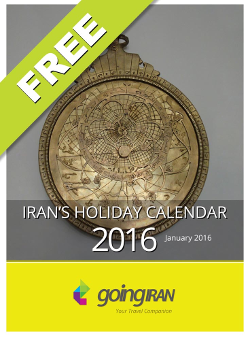Aside from the national holidays that follow the Persian Solar Calendar, many of Iran’s holidays are in accordance with events in the Islamic religion and follow the Muslim Lunar Calendar, which moves about 10 days forward each year. A few examples of Iranian holidays are:
Iranian New Year (Nowruz): Celebrated on the first day of spring, this date has been the mark of the New Year for over 5,000 years throughout several ancient cultures. It embraces the spring equinox and has been celebrated in the same unique Iranian way for the past 3,000 years. It is also deeply rooted in the Zoroastrian belief system. During this time, Iranians set up a table with a haft-sin, which is a small decorative area with seven symbolic items that is a reminder of the New Year spirit. The entire month leading up to the New Year is a time where friends and family alike all visit each other and get together. It is a very busy and pleasant time of the year.
Mehregan (Iranian Thanksgiving): Also another one of the most ancient celebrations, it is a day where everyone shows the love and appreciation they have to one another.
Shab-e Cheleh (Yalda Festival): This is the night of the winter solstice, the longest night of the year, where friends and family gather and celebrate this ancient festival. It is common tradition among the celebrations to consume seven different types of fruit and read bits of the renowned Iranian poet’s, Hafez, famous book, to one another.
Jashn-e Sadeh: 40 days after Yalda, this mid-winter celebration was held with great magnificence in ancient Iran in order to honour fire and to defeat the forces of cold and darkness.
Chaharshanbe Suri (Red Wednesday): The eve of the Wednesday before the New Year (Nowruz), is celebrated by the gathering of all, lighting of fires, and jumping over the fires. Since ancient times, this celebration of fire was one of the purification of the soul and the anticipation of spring.
Ramadan: Of the Muslim religion, Also known as Ramezan, it is an entire month where the Muslim population fast from dusk to dawn. This means not consuming any water, food or even smoking. Good to note, during this month, it is forbidden to eat or consume anything in public from dusk to dawn. Even restaurants are closed during the day, however as soon as the sun goes down, the streets, restaurants and cafes are packed!



